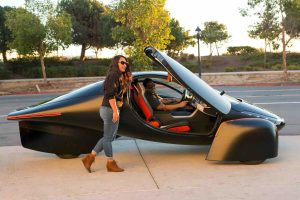The EV as it Ought to Be
GM just revealed its new electric Escalade – a huge, wastrel of an SUV that will start “around” $130,000. It’s an obscenity on so many levels it is hard to count them all.
First, if the “climate” truly is in “crisis,” then why the – expletive deleted – are vehicles such as this being made? Why are they being encouraged? Doesn’t a “crisis” require sacrifices? As in making do with less? Yet here is a vehicle that uses up probably five times as much raw materials to make it – and five times as much energy to power it – as something like the Aptera, which isn’t an affront to common sense but that probably isn’t something that uber affluent virtue-signalers want to drive.
And that’s probably why you haven’t even heard of it. So what is it?
The Aptera is a small, light, three-wheel EV that isn’t designed to virtue-signal. It is designed to be efficient as well as practical and – the big one – affordable (the projected base price of this little EV is $33,200).
In order to be those things, the Aptera cannot be anything like the Escalade EV, which weighs nearly four tons and requires the electricity equivalent of 15 gallons of gasoline to travel a supposed 450 miles (if you believe it will actually go 450 miles – in the cold – there’s a great deal to be had on a bridge that’s for sale in Manhattan). Even assuming it’s so, it’s at best a modest improvement over the 456 highway miles a non-electric (and not quite three ton) Escalade can actually travel on 24 gallons of gas, irrespective of the cold.
For $79,295.
That’s the base price of a new, non-electric Escalade. Let’s see. That’s a difference of some $50,000 to be able to not use nine gallons of gas – the extra you’d need to put in the non-electric Escalade’s tank to go the same distance GM says the electric version will supposedly go on the electric equivalent of 15 gallons.
Work out what the cost per gallon of that is. Then again, if you can afford to spend $130,000 on a vehicle, you don’t have to worry about how much gas – or electricity – you can afford.
The Aptera, on the other hand, is what an EV ought to be – if the point is to have a car that makes more sense than EVs like the battery-powered Escalade. If the point is to use less rather than waste more.
And if there really is a “crisis.”
Because it is not an energy hog. Nor is it a resources hog.
It does not need the two tons of battery needed to store the energy equivalent of 15 gallons of gas vs. the 150 pounds that 24 gallons of gas weighs that will take the non-electric Escalade (sans the weight) the same distance. It has a small battery sufficient to store the energy it needs to go almost as far ( supposedly) as the battery-powered Escalade will supposedly go – and the Aptera’s touted 400 mile range is apt to be more in line with how far it actually does go, precisely because it is not dragging around a two-ton battery (plus the rest of itself).
The Aptera’s curb weight is less than one ton.
The whole thing. The car – and the battery. Just 1,800 pounds. That’s the prototype; whether the production model can hew to that while also complying with all federal saaaaaaaaaaaaaaaaaaaafety requirements, which have helped pork up all new cars, remains to be seen.
But the point here is that Aptera is at least trying to make a light EV.
And if Aptera succeeds, an 1,800 pound pound Aptera would be hundreds of pounds lighter than any non-electric car on the market and half the weight of the “‘lightest EVs on the market (even a small EV such as the Tesla Model 3, which is a compact sedan about the same size as a Honda Civic, weighs more than most current mid-sized cars and almost as much as some full-sized cars).
If the production Aptera lives up to its 1,800 pound promise, it would weigh about the same as a ’70s Beetle.
And because it weighs so little, it can do something no other EV can do. It can make practical use of solar power – on the go.
Aptera says the car is light enough that the small amount of sun power collected by its roof-mounted solar panels can keep it going for 40 miles, without having to stop for a charge. If this proves to be doable, it will be sensational. Sun power – for free – for real. As opposed to coal and natural gas power, for real.
With other EVs, solar serves no meaningful purpose because it is not generally possible to collect enough sun power (within a reasonable amount of time) to instill sufficient motive force to move two tons of steel and glass. Let alone four. When these electric Oprahs run out of power, they stop running – and you begin waiting.
In order to be what every other EV isn’t, the Aptera is nothing like them. It does not try to be a family car. As a small (and very light) two-seater car – riding on three wheels – the Aptera is designed to be a single’s or couple’s car or a second car. Though it Aptera promises highway legs, these are not the point – though having the capability will be nice.
The point is that the Aptera accentuates the EV’s strengths by not being designed around its weaknesses. It is thus the one thing no other EV on the market is.
That being a car that might actually save you money (never mind the planet). People might actually want to buy it. And without being forced to.
Imagine that.
For these reasons, it will probably never actually become available. The government cannot allow such an EV as it would contrary to the whole point of “electrification.” Which, by now, is something all but the most starry-eyed dullards have finally clued into.



Comments
Post a Comment